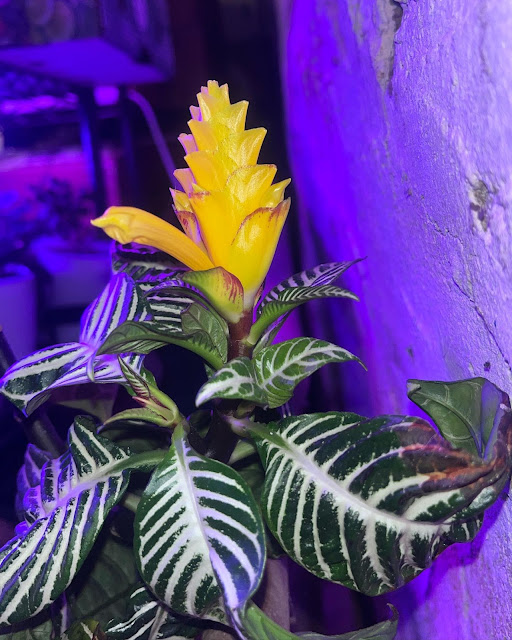Zebra Plant : Add Some Wow Factor to Your Home
The Zebra Plant, also known as Aphelandra squarrosa, is a tropical perennial plant native to Brazil. The plant gets its name from its striking foliage, which features green leaves with bold, white stripes. This plant is a popular houseplant due to its attractive foliage and ease of care. Zebra plants are a pet friendly, stunning plant that requires a little extra love and care.
History
The Zebra Plant was first discovered in Brazil in the 18th century by French botanist Jean-Baptiste Lamarck. He described it as a "most beautiful species," quickly becoming a popular ornamental plant in European gardens. The plant became even more popular in the 19th century when it was introduced to the United States.
Types Of Zebra Plant
There are several different types of Zebra Plants, each with unique characteristics. The most common type is Aphelandra squarrosa, which is known for its striking green and white striped leaves. Another popular type is Aphelandra sinclairiana, which has bright yellow flowers that bloom in the fall.
Zebra Plant Care
When caring for a Zebra Plant, it's important to provide it with the right conditions. These plants prefer bright, indirect light and high humidity. They should be planted in well-draining soil and watered when the top inch of soil is dry. Zebra Plants are sensitive to drafts and temperature changes, so keeping them in a stable environment is best.
Zebra Plant Succulent
Zebra Plant is not a succulent plant. While it is tolerant to some drought, it is not succulent and not adapted to survive in extremely dry conditions.
Propagating Zebra Plant
Take a stem cutting with a few leaves and remove the bottom leaves.
Dip the cutting in the rooting hormone and place it in a well-draining soil mixture.
Keep the soil moist and in bright, indirect light until roots have formed and new growth appears.
Zebra Plant Flower
The Zebra Plant produces spikes of yellow or orange bracts, often mistaken for flowers. The true flowers are small and located within the bracts. The bracts can last several weeks, adding a splash of color to the plant.
Zebra Plant Aphelandra
Aphelandra is a genus of plants that includes the Zebra Plant. The Zebra Plant is also known as Aphelandra squarrosa.
Haworthia Zebra Plant
Haworthia is a genus of plants unrelated to the Zebra Plant. The Zebra Plant is a member of the Acanthaceae family, while Haworthia is a member of the Asphodelaceae family.
Zebra Plant Propagation
The Zebra Plant can be promoted through stem cuttings, as previously mentioned.
Aphelandra Zebra Plant
Aphelandra is a genus of plants that includes the Zebra Plant. The Zebra Plant is also known as Aphelandra squarrosa.
How to Care for Zebra Plant
Caring for a Zebra Plant is relatively easy. Here are some tips on how to care for your Zebra Plant:
Light:
Zebra Plants prefer bright, indirect light. They can tolerate some direct sunlight, but too much direct sun can cause the leaves to turn yellow and fade. A north or east-facing window is ideal.
Temperature:
These plants prefer warm temperatures between 65-80°F (18-27°C) and should be kept away from drafts and sudden temperature changes.
Humidity:
Zebra Plants require high humidity to thrive. Keep the humidity around the plant above 50%. You can increase humidity by placing a water tray near the plant or using a humidifier.
Watering:
Water your Zebra Plant when the top inch of soil is dry. Overwatering can cause root rot, so let the soil dry out before watering again. Water the plant from the bottom and let the excess water drain away.
Soil:
Zebra Plants prefer well-draining soil that is high in organic matter. A mixture of potting soil and perlite or sand works well.
Fertilizer:
Feed your Zebra Plant a balanced, water-soluble fertilizer every 4-6 weeks during the growing season.
Pruning:
Prune your Zebra Plant to control its size and shape. Remove any yellow or dead leaves as they appear.
Pest control:
Keep an eye out for common houseplant pests such as spider mites, mealybugs, and scale insects. These can be controlled with a mixture of water, dish soap, or a pesticide specifically designed for houseplants.
You can enjoy its attractive foliage and occasional bracts for many years by providing your Zebra Plant with the right conditions.
Zebra Plant Succulent Flower
As mentioned, the Zebra Plant produces yellow or orange bracts spikes, often mistaken for flowers. These bracts can last several weeks, adding a splash of color to the plant. While the plant is not succulent, it is tolerant of some drought but needs to be kept moist.
Calathea Zebra Plant
Calathea is a genus of plants unrelated to the Zebra Plant. The Zebra Plant is a member of the Acanthaceae family, while Calathea is a member of the Marantaceae family.
Conclusion
The Zebra Plant is a tropical perennial plant native to Brazil and is known for its striking foliage with green leaves and white stripes. It is a popular houseplant due to its attractive foliage and ease of care. Zebra Plant requires bright, indirect light, high humidity, and well-draining soil to thrive.
It can be propagated through stem cuttings, producing spikes of yellow or orange bracts that are often mistaken for flowers. The plant is not succulent; it is tolerant of some drought but needs to be kept moist.
Frequently Asked Questions
Q: How often should I water my Zebra Plant?
A: Water your Zebra Plant when the top inch of soil is dry. Overwatering can cause root rot, so let the soil dry out before watering again.
Q: How can I increase the humidity for my Zebra Plant?
A: You can increase humidity for your Zebra Plant by placing a tray of water near the plant or using a humidifier.
Q: Can I put my Zebra Plant outside?
A: Zebra Plants prefer to be kept indoors, as they are native to tropical environments. They are sensitive to drafts and temperature changes, so keeping them in a stable environment is best.
Q: Will my Zebra Plant bloom?
A: The Zebra Plant produces yellow or orange bracts spikes, often mistaken for flowers. The true flowers are small and located within the bracts. The bracts can last several weeks, adding a splash of color to the plant.






Comments
Post a Comment